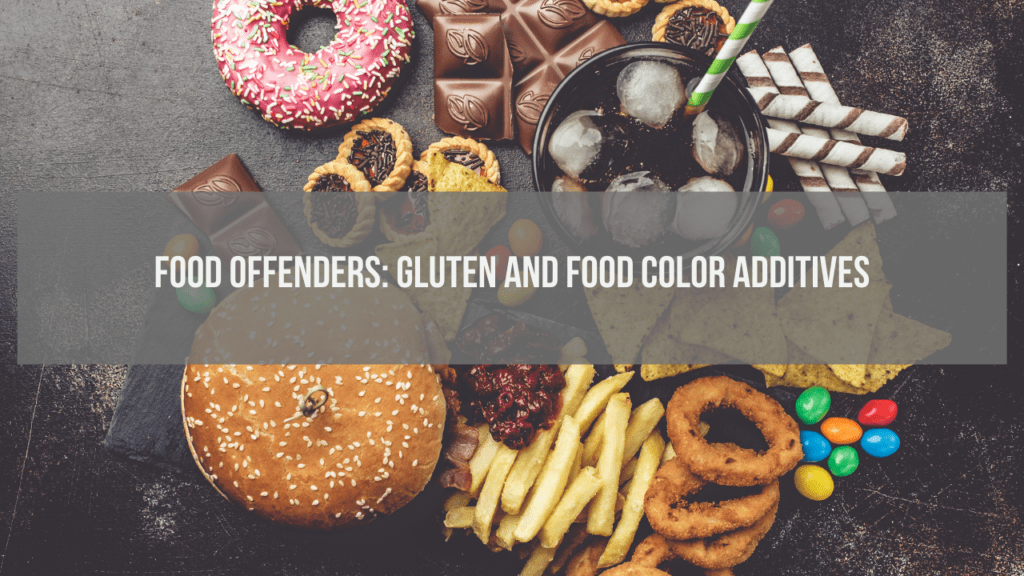Have you ever picked up an item in the grocery store to read the label and thought, “what is this stuff?” Have you blindly tossed sweets and treats into your cart not reading the label because you’d rather enjoy them in blissful ignorance? Have you noticed that after your child eats certain foods their tics, behavior, hyperactivity, anxiety, depression, OCD, or rage start increasing or spiraling out of control, sometimes for days at a time?
It’s not a coincidence! The ingredients in our foods have physical and neurological effects on our children. Foods are not what they were in the 1950s. GMO, chemically treated, bleached, nutrition stripped, lab-created, high fructose corn syrup pumped, trans fat, and color-filled foods are the centers of the American diet, and our health as a whole is suffering because of it. For kiddos with Tourette Syndrome, Tic Disorders, PANS/PANDAS, their systems go into overdrive when exposed to certain foods and additives. Two main offenders that we have identified are GLUTEN and FOOD COLOR ADDITIVES.
Gluten
According to Mayo Clinic: “Celiac Disease is an immune reaction to eating gluten, a protein found in wheat, barley, and rye. The classic symptom is diarrhea although other symptoms include bloating, gas, fatigue, low blood count (anemia), and osteoporosis.” According to the Celiac Disease Foundation: “People with non-celiac gluten/wheat sensitivity experience symptoms similar to those of celiac disease, which resolve when gluten is removed from the diet. However, they do not test positive for celiac disease. Some people experience symptoms found in celiac disease, such as “foggy mind”, depression, ADHD-like behavior, abdominal pain, bloating, diarrhea, constipation, headaches, bone or joint pain, and chronic fatigue when they have gluten in their diet, yet do not test positive for celiac disease.”
Many children and adults with tic disorders and/or PANS/PANDAS react to gluten with increased tics and/or worsened behaviors. Several studies have shown that gluten can increase intestinal permeability and cause an immune response in the body. This immune response causes inflammation which can also trigger tics, behaviors, anxiety, depression, and more. Although gluten itself may not be the culprit of increased tics and behaviors, its effects on the body and subsequent inflammation are.
Eliminating gluten from your child’s diet may decrease his/her symptoms. An elimination diet requires avoiding gluten for a period of time to see if symptoms improve. Sometimes there is an improvement but the issues are not completely resolved. It is important to understand that complex conditions like tic disorders and PANS/PANDAS usually have a variety of root causes, and gluten may be only one of them. For this reason, we recommend functional lab testing to identify and uncover all underlying issues. (Click Here to schedule an initial consult for an opportunity to work one on one with Dr. Gibson.) Here is the Hidden Sources of Gluten List provided by the Celiac Disease Foundation
Color Additives
A color additive, as defined by regulation, is any dye, pigment, or other substance that can impart color to a food, drug, or cosmetic or to the human body. The Office of Environmental Health Hazard Assessment (OEHHA) of the California Environmental Protection Agency reviewed the results of studies on synthetic food dye and behavior. In the April 2021 assessment, OEHHA states that- “The body of evidence from human studies indicates that synthetic food dyes are associated with adverse neurobehavioral outcomes in children and that children vary in their sensitivity to synthetic food dyes.” There are four main color additives that are used. In the chart below created by Jill Castle of The Nourished Child, the color additives and common foods containing them are listed.
Color additives are known as excitotoxins. Excitotoxins are chemical food additives that overstimulate neurons in the brain. When these neurons are overstimulated they quickly become exhausted and die. In short, excitotoxins can alter the chemistry of the brain. Some medical scientists believe that excitotoxins play a role in the development of many different neurological diseases, including Parkinson’s disease, seizures, and Alzheimer’s disease. (Dr. Sears) Many parents notice an improvement in their child’s symptoms once food dyes and colors are eliminated.
As if that isn’t bad enough, food coloring binds to proteins and keeps you from absorbing amino acids. Amino acids create neurotransmitters like serotonin and dopamine that help our kids to feel good, focus, and function.
Eliminating food dyes from your child’s diet may be helpful for tic reduction and behavior management. These non-nutritive excitotoxins are harmful for the brain and physically alter brain chemistry. Research shows that food color additives are likely to contribute to worsening ADHD and behavioral symptoms in children. It is surprising how many foods contain color additives. A few that really shocked us are butter, marshmallows, and pickles! Check the labels of the foods in your pantry and fridge! Here is the Food Additives Brochure provided by FDA.gov.
Gluten and Food Color Additives often cause reactions in children and adults, especially those with tic disorders, PANS/PANDAS, and/or behavioral concerns. Eliminating these two categories in foods can be very helpful. If you are looking to avoid these ingredients (or others), grocery store aisles can feel like navigating a minefield! For this reason, we have Family Health Specialists on our team to help you through the process! We offer help with proper label reading, choosing alternative items to replace the ones you currently buy, recipe revamps, meal planning assistance, and information sessions.
We want to support you in your journey of eliminating triggers for your child. Stay tuned for future blog posts explaining other foods and ingredient offenders
Sources:
https://celiac.org/about-celiac-disease/related-conditions/non-celiac-wheat-gluten-sensitivity/
https://www.fda.gov/industry/color-additives/color-additives-history
https://www.researchgate.net/publication/322404775_Food_Additives_Colorants
https://www.fda.gov/files/food/published/Food-Ingredients-and-Colors-%28PDF%29.pdf

